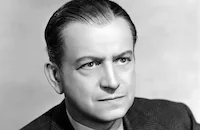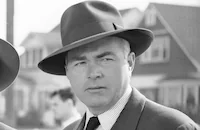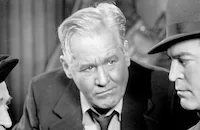To the Shores of Tripoli
Brief Synopsis
Cast & Crew
Bruce Humberstone
John Payne
Maureen O'hara
Randolph Scott
Nancy Kelly
William Tracy
Film Details
Technical Specs

Synopsis
Arrogant Chris Winters is ordered by his father, Capt. Christopher Winters, to join the Marines after he is expelled from Culver Military Academy for misbehavior. Disregarding his father's plans for his future, Chris intends to take a cushy desk job provided by the influential father of his girl friend, Helene Hunt, after he finishes basic training. Capt. Winters has written to his old friend, Sgt. Dixie Smith, asking him to toughen up Chris, and Dixie, who will be Chris's drill sergeant, takes an immediate dislike to the sarcastic recruit. The night Chris arrives at the Marine Base in San Diego, he meets Mary Carter. Chris, unaware that Mary is a Navy nurse, is impressed by her beauty and spirit and tries, half-successfully, to romance her. Mary is frightened by her attraction to Chris, however, and cuts short their evening. The next day, Chris begins training, along with fellow recruits Johnny Dent, Okay Jones, Mouthy and Butch. Chris easily masters the tasks assigned by Dixie, then helps the earnest but clumsy Johnny. Chris attempts to pursue a relationship with Mary, but she reveals that, as a nurse, she holds rank equivalent to a lieutenant and cannot fraternize with enlisted men. Mary is troubled by Chris's lack of devotion to the military, but is still jealous when Helene appears on the base one day and gets Chris to take her out. Later that evening, when Chris returns, he assures Mary that he cares only for her, and that if he takes the office job in Washington, they can conduct their romance openly. Mary turns Chris down, and soon after, Chris has more problems when he starts a fight with Dixie, whom he accuses of bullying Johnny. Chris and Dixie are arrested for the fistfight, and despite the damage it causes his career, Dixie states that he started the fight so that Chris will not get into trouble. Chris's barracks mates, angry that he caused Dixie's demotion, snub him, and Chris decides to leave with Helene. Before they can leave the camp, however, emergency maneuvers are called and Chris goes with the others to practice night maritime shelling. As Dixie leads the men in cleaning up the floating targets, he is knocked unconscious, and no one notices his disappearance until they return to the main ship. Despite the shelling, Chris finds Dixie and rescues him just before the target he is on is destroyed. Once Dixie recovers, Chris reveals that he risked his life only to erase the debt he owed Dixie for lying about the fight, and that he still intends to leave. Chris then asks Mary to accompany him, but she again replies that she belongs in the service. Chris departs with Helene, but while in the taxi, they hear a radio report about Pearl Harbor. Helene declares that the report is a fabrication concocted by Orson Welles, but when Chris sees Dixie leading his regiment through the crowd, he realizes that he truly is a Marine and must join the fight. Chris dons his uniform as he marches with the men, who are glad to see his change of heart. As they board the ship bound for overseas duty, Chris notices that Mary is already aboard, then waves goodbye to his father.

Director

Bruce Humberstone
Cast

John Payne

Maureen O'hara

Randolph Scott

Nancy Kelly
William Tracy
Maxie Rosenbloom

Henry Morgan
Edmund Macdonald

Russell Hicks

Margaret Early

Minor Watson

Alan Hale Jr.

Richard Lane
Lowell Thomas
Ted North

Frank Orth

Iris Adrian
Basil Walker
Charles Tannen
Stanley Andrews

Gordon Jones
Gaylord Pendleton
Anthony Nace
Robert Conway
Elena Verdugo
James C. Morton
Esther Estrella
Marissa Flores
Frank Coghlan Jr.
Frank Melton

Jack Arnold
Charles Brokaw
William Haade
Frank Sully

Walter Sande

James Flavin
Hugh Beaumont
Byron Shores
Knox Manning
Harry Strang
Chester Gan
Pat Mcveigh
Colin Blair
Jack Chapin

Joseph Crehan

John Hamilton
Patricia Farr

Hillary Brooke
Roseanne Murray
Crew
Alfred Cline
Edward Cronjager
Richard Day
George Dudley
A. F. Erickson
Steve Fisher
Bernard Freericks
Sgt. Henry Harris
Virgil Hart
James Havens
Roger Heman
Harry Jackson
F. E. Johnston
Ernest Joiner
Natalie Kalmus
Thomas Little
Allen Mcneil
Alfred Newman
Jacqes Offenbach
Morgan Padelford
Guy Pearce
William Skall
Sgt. Robert Smith
John Philip Sousa
Milton Sperling
J. J. Stout
Lamar Trotti
Gwen Wakeling
Darryl F. Zanuck

Film Details
Technical Specs

Award Nominations
Best Cinematography
Articles
To the Shores of Tripoli
To the Shores of Tripoli is significant for a number of film firsts. The Fox production marked the initial onscreen pairing of John Payne and Maureen O'Hara, later the stars of the Yuletide perennial Miracle on 34th Street (1947). The production was Harry Morgan's film debut, putting the Detroit-born character actor in uniform decades ahead of his beloved turn as field hospital C.O. Sherman T. Potter on TV's long-running M*A*S*H sitcom. (Morgan had gotten his first significant stage role with The Group Theater through the recommendation of friend Frances Farmer.)
To the Shores of Tripoli was also Maureen O'Hara's first film shot in Technicolor. Its warm reception at the box office in the spring of 1942 was largely responsible for the comeback of the vividly chromatic color process, which had been attempted as a two-color system during the silent era and in an improved three-color upgrade after the advent of sound. Rouben Mamoulian's Becky Sharp (1935) and Victor Fleming's Gone with the Wind (1939) were both super-productions that benefited from improvements in Technicolor but To the Shores of Tripoli proved to investors that the expensive and painstaking process could spell big profits. Although O'Hara would come to be branded "the Queen of Technicolor" by the system's co-inventor, Herbert Kalmus, the actress originally hated acting under the bright lights required to make those colors pop and complained that shooting To the Shores of Tripoli gave her a bad case of "klieg eye."
Not for nothing did industry insiders call film director H. Bruce Humberstone "Lucky." A month into shooting To the Shores of Tripoli, the Japanese Imperial Navy carried out its infamous preemptive air strike on US warships anchored at the Pearl Harbor Naval Base in Hawaii, killing over two thousand Americans, mostly military personnel. As the stunned nation mobilized for its role in what would be called the Second World War, Fox studio head Darryl F. Zanuck dispatched a second unit crew to the Pacific Theatre to photograph maneuvers and ordered script changes to capitalize on the swiftly-developing events. (The Marines had kicked Humberstone, his cast and crew out of its San Diego training depot, necessitating a hasty exodus to the Fox backlot.) While Lamar Trotti's screenplay (adapted from an original story by I Wake Up Screaming author Steve Fisher) had ended in the requisite romantic clinch between leads Payne and O'Hara (cast as a principled military nurse with a weakness for bad boys), rewrites put the principals (including Randolph Scott, as flinty drill instructor Dixie Smith) on a troop ship to anchor the Axis in the South Seas. What had begun in the Fox story department as a rote and reliable boy-meets-girl picture had ended with a patriotic flourish, resulting in a box office smash for Fox and a Technicolor recruiting video for the United States Marine Corps.
Producer: Darryl F. Zanuck
Director: Bruce Humberstone
Screenplay: Lamar Trotti (screenplay); Steve Fisher (story)
Cinematography: Edward Cronjager, Harry Jackson, William V. Skall
Art Direction: Richard Day, George Dudley
Music: Alfred Newman
Film Editing: Allen McNeil
Cast: John Payne (Chris Winters), Maureen O'Hara (Mary Carter), Randolph Scott (Sergeant Dixie Smith), Nancy Kelly (Helene Hunt), William Tracy (Johnny Dent), Maxie Rosenbloom (Okay Jones), Henry Morgan (Mouthy), Edmund MacDonald (Butch), Russell Hicks (Major Wilson), Margaret Early (Susie).
C-86m.
by Richard Harland Smith
Sources:
'Tis Herself: An Autobiography by Maureen O'Hara and John Nicoletti (Simon & Schuster, 2005)
The Film Encyclopedia by Ephraim Katz

To the Shores of Tripoli
Quotes
Trivia
Notes
The working titles of this film were The Shores of Tripoli and Tripoli. After the opening credits, narrator Lowell Thomas announces that the picture was photographed on location at the Marine Base in San Diego, CA, and that it is dedicated to Marines "everywhere, past and present" and especially to those who fought on Wake Island. According to studio publicity, "The Marine's Hymn" and "Semper fidelis" were performed for the film by the San Diego Marine Band.
A July 22, 1941 Hollywood Reporter news item noted that the studio was negotiating with George Raft for the picture's "top male role," while in September 1941, Hollywood Reporter announced that Pat O'Brien would be in the cast. Although studio publicity and Hollywood Reporter news items include Marissa Flores, Barry Norton and O. Z. Whitehead in the cast, their appearance in the completed film has not been confirmed. The picture marked the screen debut of actor Henry Morgan, also known as Henry "Harry" Morgan and later known as Harry Morgan. Morgan is best known for his portrayal of "Col. Potter" in the long-running television series M*A*S*H.
December 1941 Hollywood Reporter news items reported that after the attack on Pearl Harbor, second unit director James Havens and his crew became trapped in Honolulu, HI, where they had gone to photograph background footage for this film. For several days, the studio did not know if the men were safe, but on December 12, 1941, Hollywood Reporter announced that none of the crew had been injured. Several days later, Hollywood Reporter noted that two thousand feet of film shot by Havens' crew had been seized by the Navy, but on January 21, 1942, a Hollywood Reporter news item declared that the film had been reviewed by Navy officials and returned to the studio. Edward Cronjager and William V. Skall received Academy Award nominations for Cinematography (Color) for their work on To the Shores of Tripoli.
According to a April 1, 1942 Hollywood Reporter news item, the studio intended to make a Technicolor recruiting short for the Marine Corps with unused footage from To the Shores of Tripoli. The short was to be narrated by Tyrone Power and written by Lamar Trotti. April and June 1942 Hollywood Reporter news items noted that the film was helping to increase the number of new recruits entering the Marines. A August 24, 1942 Hollywood Reporter news item stated that writer Jack Andrews and producer Milton Sperling were working on a story entitled "Battle Stations," which was to tell the story of the Marine Corps between the two World Wars and be a "follow-up" to To the Shores of Tripoli. That film was not produced, however.















